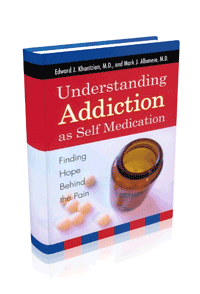Publication
Article
PsychiatricTimes.com
Understanding Addiction as Self Medication: Finding Hope Behind the Pain
Author(s):
Why do people get addicted? Of the countless books that have been published on this topic, this is the first that focuses on the self-medication hypothesis (SMH). Understanding Addiction as Self Medication is largely based on the experiences of the authors and other clinicians with individuals who struggle with addiction.
Why do people get addicted? Of the countless books that have been published on this topic, this is the first that focuses on the self-medication hypothesis (SMH). Understanding Addiction as Self Medication is largely based on the experiences of the authors and other clinicians with individuals who struggle with addiction.
The book outlines the SMH for the target audience-the concerned citizen. The authors explain that individuals who self-medicate to treat emotional dysfunction are likely to become addicted. They cite various books, texts, and patient cases as support for the SMH. Many of those cases stress that addicts select a “drug of choice” through experimentation that counteracts the individual’s specific emotional suffering. If the individual has high levels of anxiety and stress, for example, the drug of choice may be alcohol to help him or her relax. This example and many others show that individuals initially use drugs to help cope with emotional distress.
Soon after beginning self-medication, a physical tolerance develops that requires the person to increase the dosage to achieve the same emotional relief. Physical tolerance leads to dependency on the drug; sudden withdrawal of that drug causes withdrawal symptoms that often compound the emotional distress.
Drs Khantzian and Albanese stress that it is not just psychological factors that lead to addiction but also a complex interaction with biological factors. The authors have included sections that evaluate the contributions of emotional dysfunction, psychiatric disorders, and neurophysiology. They recommend that the treatment of addiction should address both the addiction itself and the underlying psychological distress.
The book and particularly the chapter on the neurophysiology of addiction could benefit from illustrations to help explain the more complex mechanisms of the SMH. However, summaries at the end of each chapter review patient cases and reemphasize the main points.
Although relatively brief, this book serves as a good introduction to the SMH of addiction.







